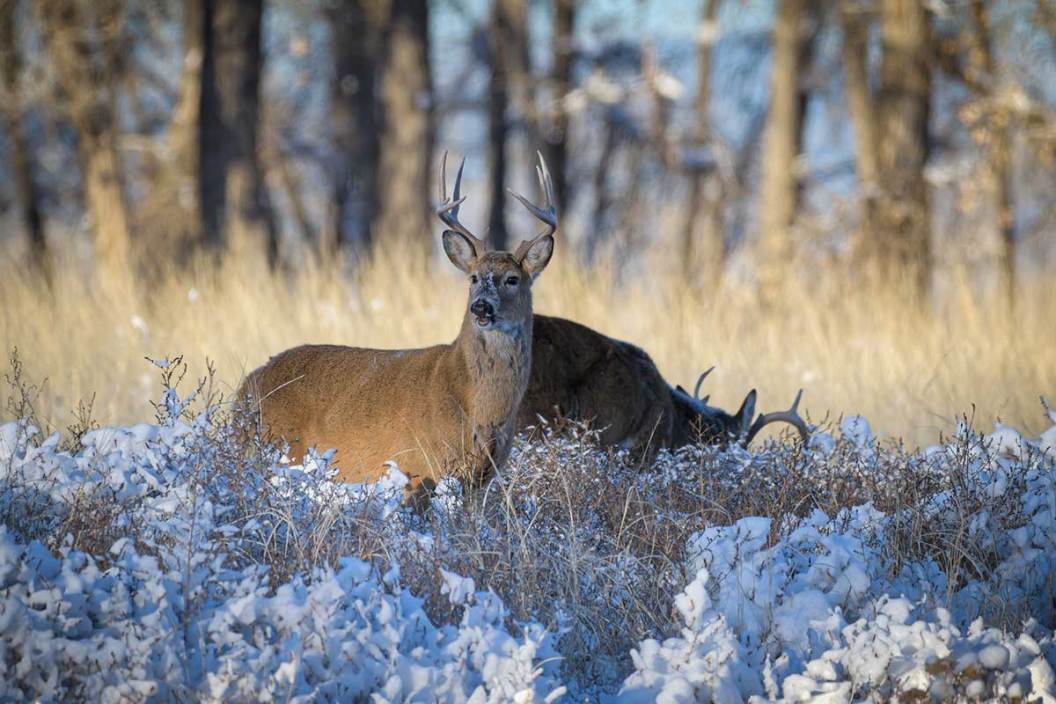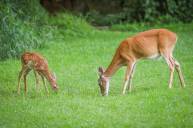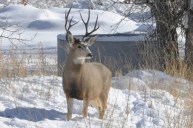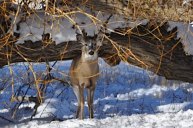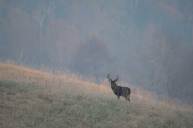Should we be feeding deer in the winter? Here's why it seems like it would help, but it really doesn't.
Providing a food source for wild deer might seem like a helpful thing to do, with the added benefit of watching wildlife interact out the kitchen window. What's the harm, right?
Sorry, but the experts pretty much all agree that's wrong.
Feeding whitetail deer, mule deer, or other wild ungulates during the cold winter months makes the already difficult situation they are in worse, not better.
Why We Should Not Feed Deer in the Winter
Giving deer supplemental food interrupts their natural winter patterns and makes them more vulnerable to disease, starvation, predation, vehicle collisions, and more.
Whitetail deer have natural defenses to help get them through the brutal, snowy seasons. According to the University of New Hampshire's Wildlife Outreach Program, deer develop a thick winter coat of hollow hairs in autumn and an accumulation of fat storage to sustain them during the coldest parts of the year. They estimate that adult deer get as much as 40% of their daily energy during winter from their stored fat tissue.
Here's where things get potentially tragic. This energy source is finite; once the deer loses its winter fat it is at a higher risk of winter mortality. Any activity that burns energy can lead to death for the deer if the fat reserve runs out before the winter season does.
A deer's natural instinct is to pursue softwood cover to avoid the deep snow, high winds, and extreme cold that open areas expose them to. Deer will winter in these protected areas. While wintering in the softwood, deer eat the naturally available vegetation around them. They travel on a network of trails collectively created in the snow and move around as little as possible to conserve energy. When in large groups, wintering deer disperse in the softwood cover over an area large enough to sustain the population. This will reduce competition for food and provide protection from predators. This natural method relies on cover, not feed, for winter survival.
Winter can be harsh on wildlife, and some of the deer population will succumb to starvation, predation, and/or the elements, but introducing an unnatural food source does not prevent or reduce this.
More Harm Than Good
Providing feed seduces the deer out of the softwood cover and creates unnaturally high concentrations near the food source. These high deer densities can spread illness among deer populations, attract predators, cause aggression and violence among deer as they fight for the limited feed, and cause reduction of the vital fat reserves that deer need to sustain them over winter as they travel to and from the feed site.
The Pennsylvania Game Commission agrees that feeding deer during the winter months does more harm than good, and mentioned the spread of Chronic Wasting Disease (CWD). CWD is an always-fatal, quickly spreading neurological illness that affects deer. Providing food to deer creates an unnatural congregation around the feed sites, which increases the transmission of disease among deer herds. And it is not just CWD that poses a risk.
"Supplemental feeding congregates deer in unnatural densities," the Pennsylvania Game Commission said. "Gathering large numbers of deer into small areas creates a serious risk for spreading terminal diseases such as chronic wasting disease and tuberculosis. Mange is another disease that spreads between animals in close contact. The spread of disease within and among species is encouraged by repeated and prolonged contact at feeding sites."
Many states across the country have laws on the books prohibiting the intentional feeding of wild deer, except under specific circumstances. Some of these states are Virginia, New York, New Jersey, and Vermont, among others.
Products featured on Wide Open Spaces are independently selected by our writers and editors. However, when you buy something through our links, we may earn a commission.
NEXT: THE PERFECT TIME TO START THINKING ABOUT SHED HUNTING
